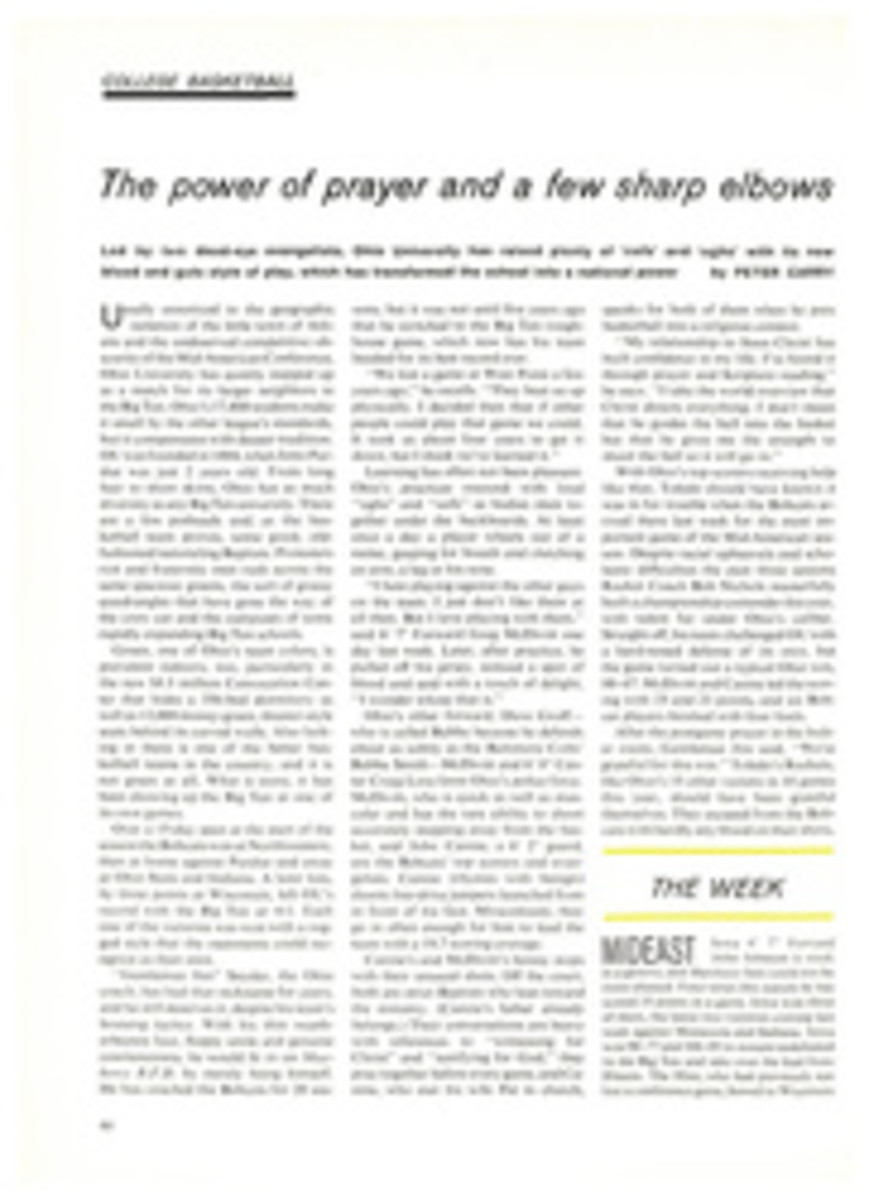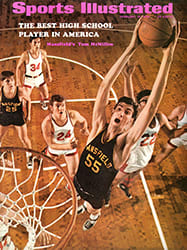
A LITTLE MURDER SET TO MUSIC
It is all so terribly refined—a little blood sport performed to a Beethoven score. Figure skaters get their competitive urge in the cradle, along with mother's milk, and behind the sequined facade of the game are often sharp and cutting rivalries—they don't hone their skate blades for 15 or 20 years for nothing. Last week, amid charges, countercharges and a few verbal slashes, the country's best figure skaters met blade to blade in the national championship in Tulsa. The defending champions, Tim Wood and Janet Lynn, got the trophies and everyone else got Band-Aids.
For Wood it was his third straight U.S. title, and he is now a heavy favorite to defend his world crown successfully next month in Yugoslavia. He is a conservative champion, a master technician who calls himself a human compass and performs with the mechanical precision of one. Because he has done his homework studiously and for a very long time (he has been skating since he was 3), Wood gets top marks in the school figures, that compulsory part of the program in which a skater must prove he knows his basics. But the by-the-book approach that makes him almost faultless in figures sometimes flaws his free skating. In the interpretive half of last week's championship, there were some who felt Wood might be upset by the derring-do of John Misha Petkevich, a Cossack on skates.
"Misha is an artist," an admirer explained. "If he has a good night and a good audience he can be fabulous." Petkevich has never found skating school figures emotionally fulfilling. He has had plenty of opportunity to learn precision—his parents used to arrange for private half-hour lessons and rented a private patch of ice for him when he was 2—but at 20 Misha feels he is only now getting into the groove.
A third-year pre-med student at Harvard, Petkevich razzle-dazzled his way into skating prominence in the 1968 nationals with a free-skating performance that saw him soaring around Philadelphia's Spectrum like a Frisbee. After that he enrolled in Harvard and waxed fat and contented in his Cambridge dorm until his mother arrived from Great Falls, Mont. She was appalled by her son's thickening girth and the institutional food he was eating. Leaving her husband home, Mrs. Petkevich moved to Cambridge, rented an apartment and cooked dietetic meals down to the last cookie crumb for her son. He lost weight but, unfortunately, lost strength, too, and he had a lean 1969 all the way around, never really threatening Wood in competition.
Petkevich showed up at this year's nationals in considerably better form. After the compulsory figures on Thursday he was 35 points behind Wood (which could be considered a triumph of sorts since he had lagged 51 points behind Wood in the figures in 1969).
Free skating is Petkevich's game and for him always a gamble. In an uptight, high-button-shoe sport, he is regarded as the house rebel. He acquired the reputation some years ago by showing up for a competition in a turtleneck instead of the customary bolero jacket. The judges were horrified, and one wrote a chiding letter to Mrs. Petkevich for permitting such teen-age folly. So it was in tune with his character for Petkevich to choose radical skating music for his freestyle performance last week. In terms of skating's traditions his selection of On the Waterfront was as inappropriate as picking Alice's Restaurant as mood music for a Selective Service banquet.
Tim Wood, for one, was a bit testy about the liberties Petkevich was taking in putting together his skating program. "I flow faster than anyone on ice," Wood said. "My style is sharp, clean and simple, and I make my jumps look easy. There is never anything wrong, and that makes what I do look simple and easy to an ignorant audience. That's why I believe it is wrong to play to an audience. You knock yourself out and they sit on their hands. John Misha is a completely different skater. He goes for big, high jumps. But if you stop and look between those, right before and right after, it's a rough performance and scratchy. I don't know if it is right for him to skate that way. Personally, I want to skate for skating's sake and the beauty of it, and to show perfection for perfection's sake."
On Friday night Petkevich appeared for the freestyle in a black jump suit and white-lace shirt made from brassiere material—an outfit specially designed by Bergdorf-Goodman, that elegant New York store. From the start the crowd showed its partiality: during the warmup period Wood received the polite patter due a champion but Misha got the bursts of applause and shouted encouragement.
Petkevich's personal mood was a key to his performance. "I thought of speed, of feeling strong," he said later. "Sometimes the building is large and you pull yourself up. You feel strong and you become large and the building becomes small." He came on to the intense beat of drums, the drama of cymbals—and suddenly skating was being pushed centuries forward to the stark, leaping, stylized dances of West Side Story. The ignorant audience clapped delightedly, as much for Petkevich's creative gall in the face of five judges (two of whom disapproved) as for his split mazurka.
Five minutes later the sport was once more its sedate old self—with woodwinds and a ballet by Tim Wood. The defending champion is lithe, gliding and indisputably classic. "He's a skater's skater," said one appreciator of his art. "Good technique makes it look simple and elegant. Poor technique makes it look brash and bold." So the judges gave Wood the gold medal. It will be added to 15 others that he has won, which hang from his mother's charm bracelet.
It also is about time Mrs. Ethylene Nowicki of Rockford, Ill. invests in a bracelet, too, for her 16-year-old daughter, Janet Lynn (she dropped the Nowicki when she was 6 just in case she became a skating star), is being groomed as America's next grand champion. She is long-lashed, blonde and fluffy, but inside she is a coiled spring of determination—all covered over with cat-that-ate-the-canary innocence.
Since she was 9 Janet has been appearing at the nationals, and last year at 15 she won the Senior Ladies' title by a skate-edge-slim hundredth of a point. The girl she nudged out of the limelight, Julie Lynn Holmes, got her revenge at the world championship, finishing fourth to Janet's fifth. "Julie has been pecking at us ever since," said Slavka Kohout, Janet's coach.
Now bring on Julie Lynn Holmes. Her coach is Carlo Fassi, the man who tutored ex-champion Peggy Fleming, and, perhaps understandably, a little of Peggy's graceful style has rubbed off on Julie. "Fassi is trying to cover the waterfront," a critic noted acidly. "Julie used to be a dynamic skater. Now she's a copy of Peggy Fleming with a bit of Janet Lynn on the side."
Miss Kohout had something to say on the subject, too. "Fassi is having Julie copy the position of Janet's hands," she charged. "How can she do it—it's a matter of integrity! We've worked six months to develop those original hand placements. We skate after Julie in the championship and now it will look as if we have copied her." Fassi retorted that it was he who had been robbed. So much for skating's petty larcency.
As defending champion, Janet was the favorite—but only a slight one. In six years of skating competition she had only managed to win the compulsory figures (which count 50% toward a title) on three occasions. She had finished fourth in figures in the nationals last year and had to come from behind in the free skating to win the title. "School figures require a maturity of mind," Miss Kohout explained. "It takes a depth of concentration which Janet is only now beginning to achieve. But her figures are 100% better than last year."
The draw put Julie and Janet next to each other in the field of 11, which only intensified the rivalry. Julie got off to an early lead and she continued in front until the next to last figure. There Janet did a superb tracing and moved ahead for the first time. Everything depended on the final figure—and the two girls were the only skaters left on the ice. Julie laid out an adept, if not exactly perfect, figure. Janet followed with what appeared from the grandstand to be a pattern of wobbling circles. Thinking all was lost, she burst into tears and was hurried from the arena.
Several hours later the judges posted the final scores. To the astonishment of not a few people, Janet Lynn was named the winner. When asked about the decision, Miss Kohout said, "They've given Janet the go-ahead to be a champion. Tomorrow we'll see if she can skate like one."
At the women's freestyle finale the crowd was vocal and divided. There were high-pitched cheers from every part of the stands as the skaters' young partisans shouted, "Yea, Julie," "Yea, Janet," sounding, at times, like Brownie Scouts whooping it up over a close sack race. Julie was getting the most fervent cheers, but Janet—now confident and undismayed—sped across the ice like a dervish in her warmup.
Julie performed first, moving in a ripple of red chiffon through a gay and lilting routine. But suddenly she fell, and down with her went her chance for the championship. No one can say, however, that Janet Lynn won her title by default. She skated swiftly and with exhilaration. Wind streaked through her hair, and with a crescendo of whirls and jumps she had the crowd on their feet. She left them cheering, waved as she left the ice and moved toward the television cameras with the sureness of a champion. Chances are she'll be sparkling in front of those bright lights for years. And through it all they'll play Beethoven. Janet Lynn will look beautiful and her sport terribly refined.
PHOTO
Poised for her performance, Julie Lynn Holmes gets rinkside advice from Coach Carlo Fassi.
PHOTO
Flashing the pixielike smile: champion Lynn.

